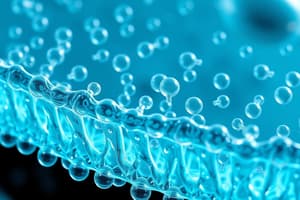Podcast
Questions and Answers
What are phospholipids derived from?
What are phospholipids derived from?
Triglycerides
Phospholipids are amphiphilic molecules.
Phospholipids are amphiphilic molecules.
True (A)
What is the key lipid substance produced by the liver that is a key building block of cell membranes?
What is the key lipid substance produced by the liver that is a key building block of cell membranes?
Lecithin
In addition to phospholipids, what other compounds are involved in the structure of cell membranes?
In addition to phospholipids, what other compounds are involved in the structure of cell membranes?
What is the primary function of phospholipids in the body?
What is the primary function of phospholipids in the body?
What type of hormones are Eicosanoids?
What type of hormones are Eicosanoids?
What is the primary action of Eicosanoids in the body? (Select all that apply)
What is the primary action of Eicosanoids in the body? (Select all that apply)
Flashcards
Phospholipid Structure
Phospholipid Structure
A triglyceride derivative with a phosphate group replacing a fatty acid.
Amphiphilic Nature
Amphiphilic Nature
Phospholipids have both water-fearing (hydrophobic) and water-loving (hydrophilic) parts.
Phospholipid Function
Phospholipid Function
A major component of cell membranes.
Lecithin Composition
Lecithin Composition
Signup and view all the flashcards
Lecithin Production
Lecithin Production
Signup and view all the flashcards
Lecithin Function
Lecithin Function
Signup and view all the flashcards
Eicosanoid Role
Eicosanoid Role
Signup and view all the flashcards
Eicosanoid Functions
Eicosanoid Functions
Signup and view all the flashcards
Eicosanoid type
Eicosanoid type
Signup and view all the flashcards
Lipid Function
Lipid Function
Signup and view all the flashcards
Hydrophilic
Hydrophilic
Signup and view all the flashcards
Hydrophobic
Hydrophobic
Signup and view all the flashcards
Triglycerides
Triglycerides
Signup and view all the flashcards
Cell Membrane Component
Cell Membrane Component
Signup and view all the flashcards
Lecithin Importance
Lecithin Importance
Signup and view all the flashcards
Lipid group
Lipid group
Signup and view all the flashcards
Central Nervous System (CNS)
Central Nervous System (CNS)
Signup and view all the flashcards
Signaling Hormone
Signaling Hormone
Signup and view all the flashcards
Inflammation
Inflammation
Signup and view all the flashcards
Immunity
Immunity
Signup and view all the flashcards
Study Notes
Phospholipids
- Phospholipids are triglycerides with one fatty acid replaced by a phosphate group.
- They are amphiphilic molecules – meaning they have both hydrophobic (water-fearing) and hydrophilic (water-loving) regions.
- The molecule's structure is partially hydrophobic and hydrophilic.
Lecithin
- Lecithin is a key lipid produced by the liver.
- It's a vital component of cell membranes.
- Lecithin is a combination of glycolipids, triglycerides, and phospholipids.
- It's useful for transporting fats and cholesterol.
Eicosanoids
- Eicosanoids are signaling hormones.
- They control many bodily functions, including the inflammatory response and the immune system.
- They act as messengers for the central nervous system (CNS).
Studying That Suits You
Use AI to generate personalized quizzes and flashcards to suit your learning preferences.




